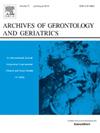数据驱动的 MCI 亚型中一般认知功能和日常功能的纵向轨迹:对老年人的纵向队列分析。
IF 3.5
3区 医学
Q2 GERIATRICS & GERONTOLOGY
引用次数: 0
摘要
目标:根据数据得出轻度认知障碍(MCI)亚型,并描述 MCI 亚型中一般认知功能和日常功能随时间的复杂变化:得出数据驱动的轻度认知障碍(MCI)亚型,并描述MCI亚型的一般认知功能和日常功能随时间的复杂变化:共纳入了813名在阿尔茨海默病神经影像学倡议(ADNI)中基线诊断为MCI的受试者。通过基于组的多轨迹建模(GBMTM)分析,利用视觉空间功能、语言和执行功能等认知领域的纵向测量得分,得出数据驱动的MCI亚型。一般认知功能和日常功能分别由小型精神状态检查(MMSE)和功能评估问卷(FAQ)测量,其纵向轨迹变化由线性混合模型描述:结果:得出了三种 MCI 亚型,即 "认知功能衰退组"、"轻度认知功能衰退组 "和 "无认知功能衰退组"。轻度认知功能衰退组 "在样本中所占比例最高(46.2%),其次是 "无认知功能衰退组"(35.2%)。认知功能下降组 "患者的基线平均年龄最高(74.69 岁),APOE ε4携带者比例最高(63.2%),痴呆转化率最高(77.0%)。在最初的36个月中,"认知功能下降组 "的MMSE和FAQ评分变化轨迹最快,而 "无认知功能下降组 "的变化轨迹最慢:结论:MCI患者可细分为更精细的认知亚型,识别这些不同的MCI亚型及其不同的认知衰退轨迹可能对改善临床病程预测具有重要的预后价值。本文章由计算机程序翻译,如有差异,请以英文原文为准。
Longitudinal trajectories of general cognitive and daily functions in data-driven subtypes of MCI: A longitudinal cohort analysis of older adults
Objectives
To derive data-driven subtypes of mild cognitive impairment (MCI) and characterize the complicated changes of general cognitive and daily functions over time in MCI subtypes.
Methods
A total of 813 subjects diagnosed as MCI at baseline from the Alzheimer's Disease Neuroimaging Initiative (ADNI) were included. Data-driven MCI subtypes were derived from group-based multi-trajectory modeling (GBMTM) analyses using longitudinal measurement scores in the cognitive domains of visuospatial function, language, and executive function. General cognitive and daily functions were measured by the Mini-Mental State Examination (MMSE) and the Functional Assessment Questionnaire (FAQ), respectively, whose longitudinal trajectory changes were depicted by Linear mixed models.
Results
Three MCI subtypes were derived, which were defined as “Cognitive decline group”, “Mild cognitive decline group” and “No cognitive decline group”. The “Mild cognitive decline group” had the highest percentage in the sample (46.2 %), followed by the “No cognitive decline group” (35.2 %). Patients in the “Cognitive decline group” had the highest mean age (74.69 years) at baseline, the highest APOE ε4 carriers (63.2 %), and the greatest dementia conversion rate (77.0 %). The changes in MMSE and FAQ score trajectories were fastest in the “Cognitive decline group” in the first 36 months and most slowly in the “No cognitive decline group”.
Conclusion
MCI individuals could be subdivided into more fine-grained cognitive subtypes, and identifying these distinct MCI subtypes and their different trajectories of cognitive decline may have important prognostic value for improving clinical course prediction.
求助全文
通过发布文献求助,成功后即可免费获取论文全文。
去求助
来源期刊
CiteScore
7.30
自引率
5.00%
发文量
198
审稿时长
16 days
期刊介绍:
Archives of Gerontology and Geriatrics provides a medium for the publication of papers from the fields of experimental gerontology and clinical and social geriatrics. The principal aim of the journal is to facilitate the exchange of information between specialists in these three fields of gerontological research. Experimental papers dealing with the basic mechanisms of aging at molecular, cellular, tissue or organ levels will be published.
Clinical papers will be accepted if they provide sufficiently new information or are of fundamental importance for the knowledge of human aging. Purely descriptive clinical papers will be accepted only if the results permit further interpretation. Papers dealing with anti-aging pharmacological preparations in humans are welcome. Papers on the social aspects of geriatrics will be accepted if they are of general interest regarding the epidemiology of aging and the efficiency and working methods of the social organizations for the health care of the elderly.

 求助内容:
求助内容: 应助结果提醒方式:
应助结果提醒方式:


